Shu Zheng Valley
Shu Zheng Valley is reputed as the epitome of Jiuzhai Valley National Park. Its renowned, unpredictable independent lakes and lake clusters, colourful forests, colourful “beaches”, century-old grinding wheels, wooden bridges and powerful waterfalls are one of the high points of a visit here.
He Ye Village
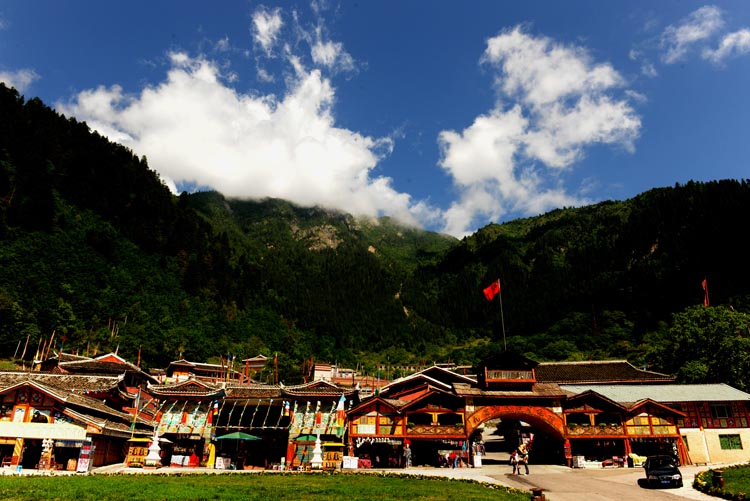
The first and largest Tibetan village in Jiuzhai Valley National Park. You will notice its Tibetan architecture and its dramatic scenery in the autumn. At the back of the village is a giant pine tree, some 100 years old, with exuberant branches. It is called the "Welcome Pine", as its branches are said to spread and beckon visitors while displaying its respect!
Bonsai Shoal
Altitude 2,240m.
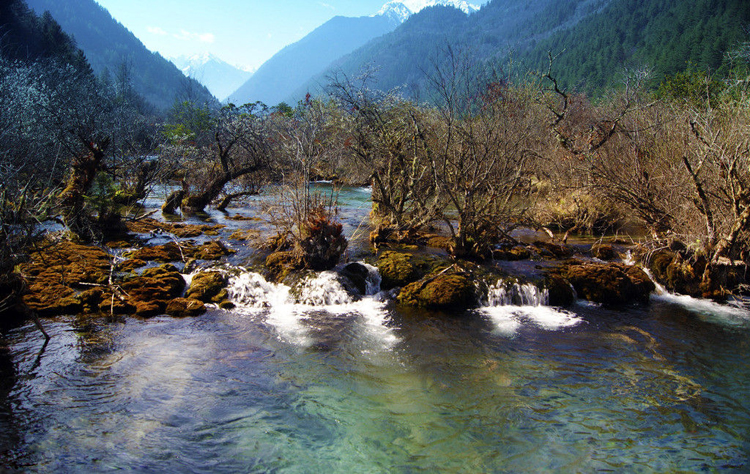
The Bonsai Shoal (Pen Jing Tan) is a stretch of travertine beaches, on which slow water blankets sweep through weeds, poplar, azaleas, pines, cypresses, willows and other shrubs. The water runs through woods that stand in various poses. It is believed that the mountain God placed a wonderful bonsai collection here that exceeds the best of human art works.
Reed Lake
Altitude 2,140m, area over 100,000 sq. m.
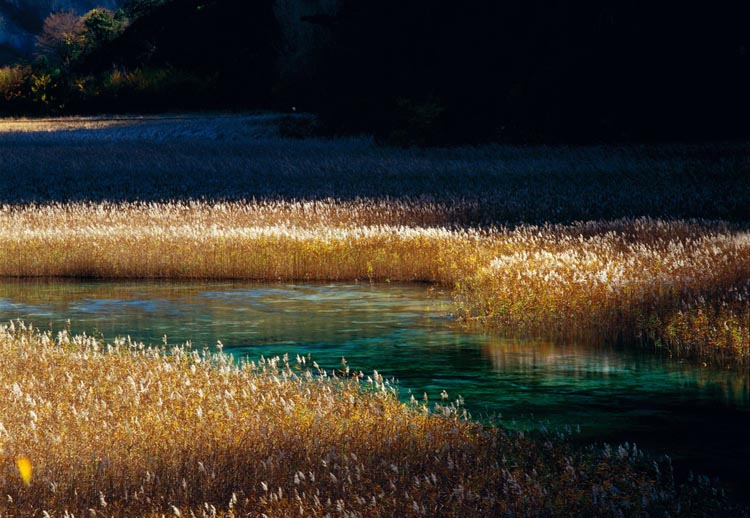
The Reed (Lu Wei) Lake is a semi-swamp lake with thick reeds throughout, where the blue and green “Jade Ribbon” stream runs through the reed stems down towards the valley entrance. In spring and summer, transparent currents and reeds share the same green colour; in autumn and winter, reeds turn eye-striking golden yellow. Soft reed flakes float in the air, attracting herons and wild swans to the water side.
Jia Wu sacred mountain
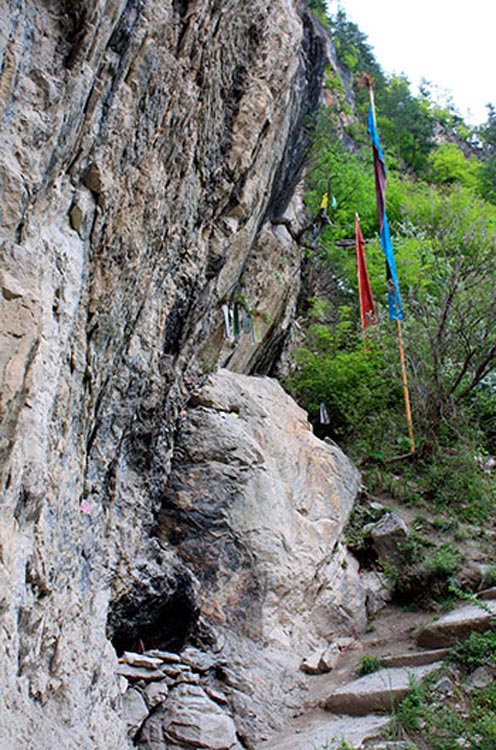
At the farthest end of the Reed Lake (Lu Wei Hai) lies the Jia Wu Sacred Mountain. At its foot is the remains of a 5m Buddhist pagoda, only its base has survived the passing of time. Local people regard it as their "sacred altar" to which they come for heaven's blessings. On the 15th day of every month of the lunar calendar or during Tibetan festivals, it may be possible to observe locals performing an ancient religious mountain and water worship ceremony here.
Sparkling Lake
Altitude 2,187m, depth 9m, area 36,000 sq.m.
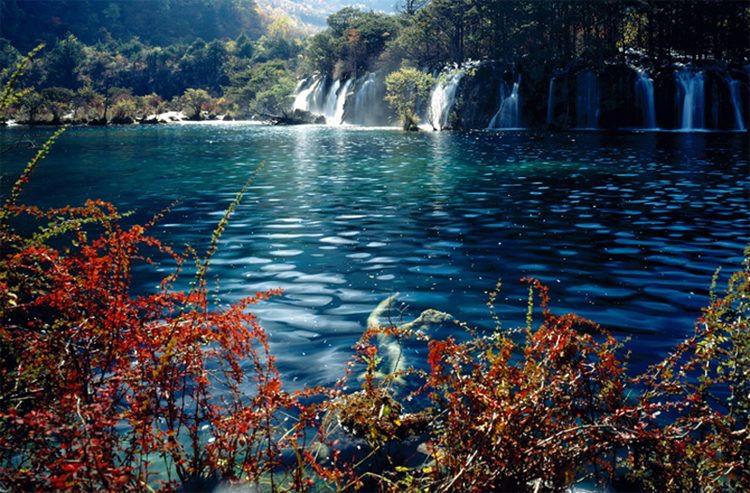
Sparkling (Huo Hua) Lake, features azure blue colours and lies in between dense woods. The lake is filled from the Huo Hua Lake Waterfalls which are 50 metres wide and 8 metres tall.
Lying Dragon Lake
Altitude 2,215m, depth 22m, area 61,000 sq.m.

The small and exquisite Lying Dragon Lake (Wo Long Hai) is typical of Jiuzhai Valley's fabled blue, gem like lakes. The tufa formation under the water is believed to resemble a dragon.
Shu Zheng Lakes
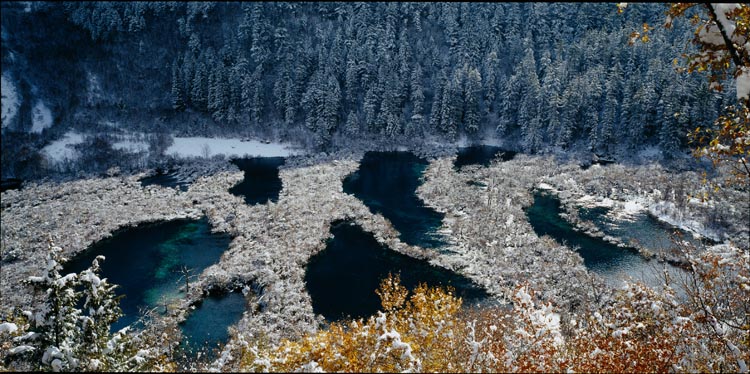
With a drop of about 100 meters from start to finish, Shu Zheng Lakes (Shu Zheng Qun Hai) has 19 lakes of varied sizes, descending in terraces. Among these lakes grow dense groves of willows, poplars, pines, spruces and other plants. Water climbs over dikes and runs through groves' stems. High and low levels of the lake clusters are clearly marked, featuring spectacular colours, verdant woods, dark-blue water, and waterfalls. This wonderful scenery is considered by many to be the “epitome of Jiuzhai Valley” and it is one of most photographed sites in the park.
Shu Zheng Village
Shu Zheng Village has the busiest of all the villages in Jiuzhai Valley. Log houses stand one after the other and prayer flags wave in the breeze. Many of the locals here operate small stores and sell various Tibetan souvenirs as well as yak butter tea and snacks.
Shu Zheng Waterfall
Altitude 2,295m, width 62m-72m, height 25m.
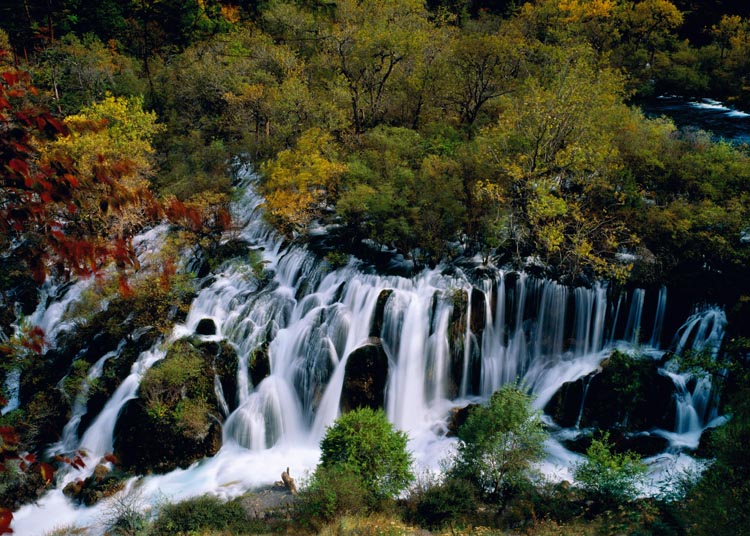
It is a round multi-level waterfall with thousands of water streams running through the stems and trunks of the plant life that grows from it.
Tiger Lake
Altitude 2,298m.
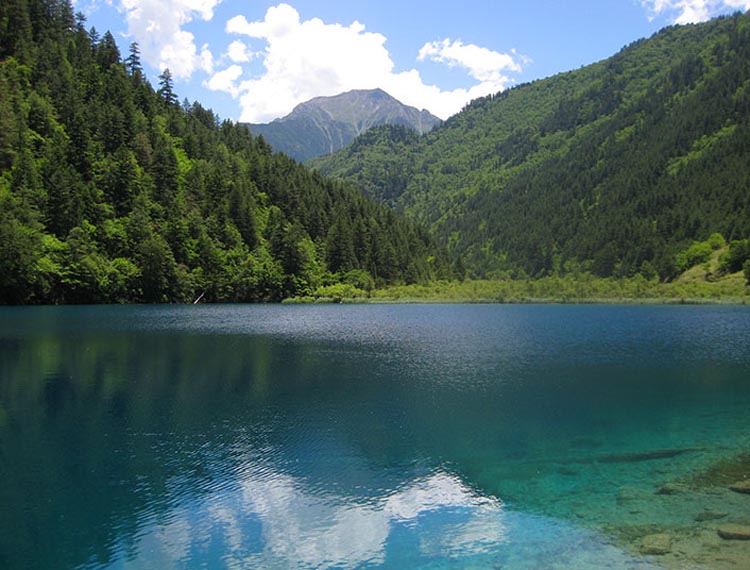
Tiger Lake (Lao Hu Hai) was named for a number of different reasons. Firstly the Shu Zheng Waterfall at its northern end roars like a tiger. Also, when the leaves change colour in the autumn the reflection is said to resemble a tiger’s pattern.
Rhinoceros Lake
Altitude 2,325m, average depth 12m, length
2km, area 200,000 sq.m.
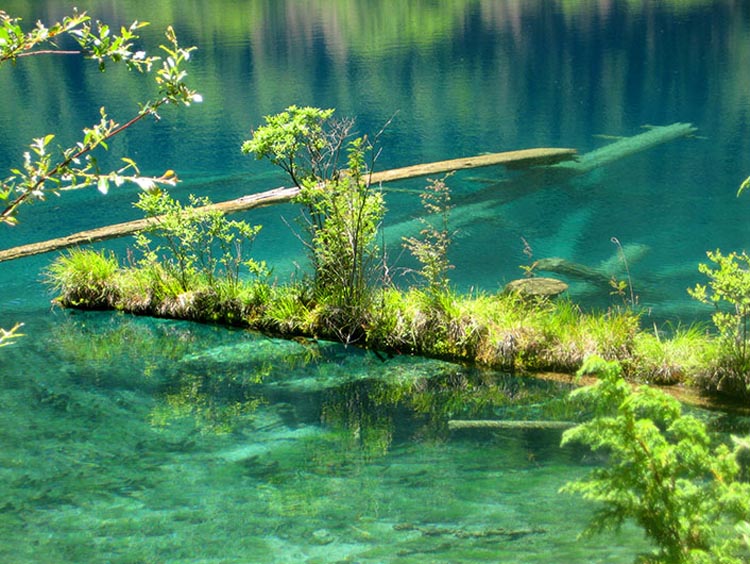
Rhinoceros Lake (Xi Niu Hai) is the second largest in Jiuzhai Valley after Long Lake (Chang Hai). In spring and summer the dense woods and grasses are a lush green followed by autumn where the red, brown and green colours provide a stunning reflection in the lake’s surface.
Nuo Ri Lang Waterfall
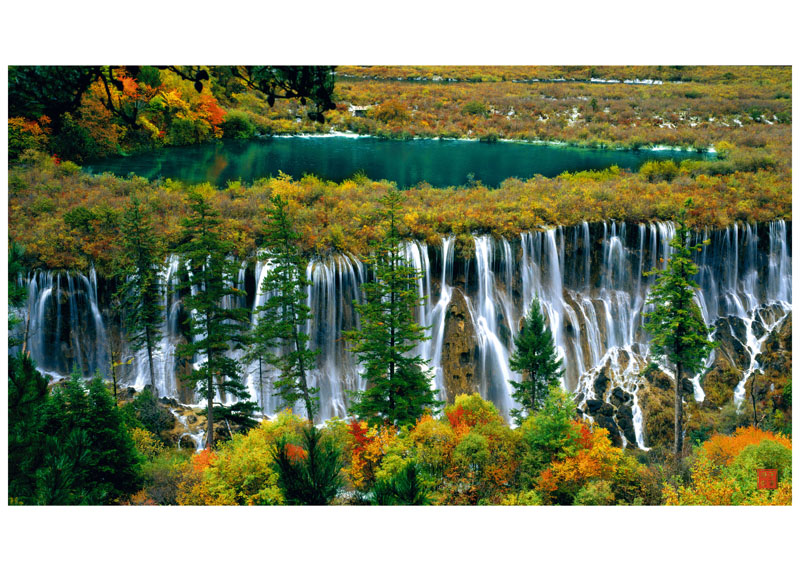
This is the widest travertine topped waterfall in the world and one of the signature pictures of Jiuzhai Valley. During the late summer when the water level is at its highest, the noise of Nou Ri Lang waterfall alone is impressive. During the winter the waterfall usually freezes creating an enormous ice curtain.
Ze Cha Wa Valley
Ze Cha Wa Valley stretches 18km from Nuo Ri Lang to Long Lake (Chang Hai) at the joint point of the park. The valley features overlapping, high valleys, 2 seasonal lakes and Jiuzhai Valley’s largest lake.
Ze Cha Wa Village
Located next to the fork in the road, at the centre of the “Y”, there are some beautifully decorated homes that can be admired while stopping here for a quick snack or a cup of yak butter tea. It is just above the bus stop that goes from the Nuo Ri Lang Centre to the Long Lake. There is a basketball court opposite the village, where many of the locals play basketball. Basketball courts are common in the villages of the area, a sign of the modernising times perhaps.
About 500m further along the road, the old Ze Cha Wa Village can be seen further in from the road. The locals moved from these older wooden homes to more solid homes in the late 1980s and early 1990s.
Upper and lower seasonal Lakes
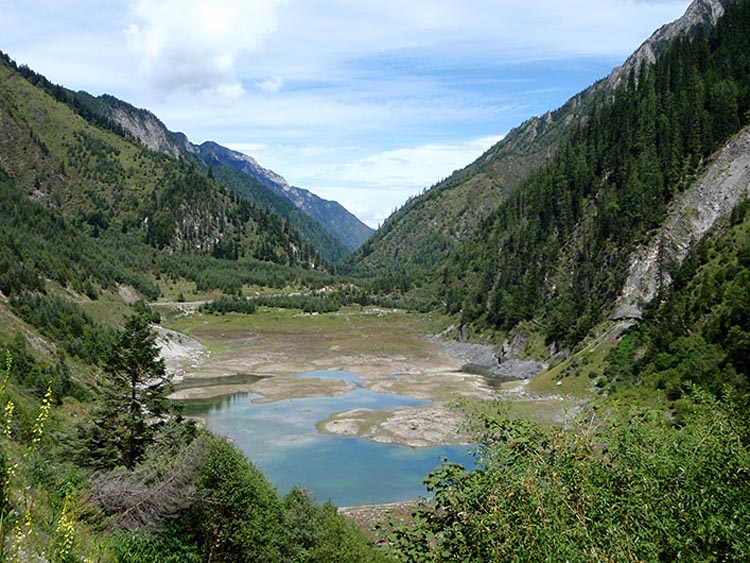
There are two seasonal lakes in Ze Cha Wa Valley quite a distance from each other, with distinctive features. The lower seasonal lake is close to Ze Cha Wa Village, with a stretch of birches, wild strawberries, grass and fungi in between.
The upper-seasonal lake neighbours the Five-Coloured Pond (Wu Cai Chi), with steep cliffs surrounding. This is said to be the place where fierce dragons hide themselves and is also called the “Tibetan Dragon Lake”. In the dry season, the Class 1, UN protected, “Ruswich” flower grows on the lakebed.
Five Coloured Pond
Altitude 2,995m, depth 6.6m, area 5,645 sq.m.
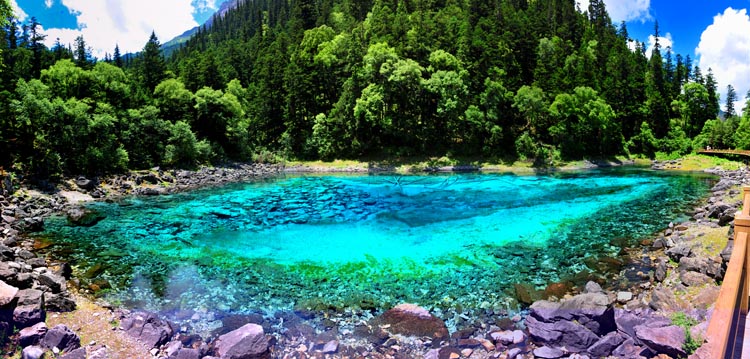
The Five Coloured Pond (Wu Cai Chi) is one of Jiuzhai Valley’s smallest but most impressive lakes. Its colours are a result of travertine sedimentation on the uneven lake bed, as well as various algae. However, legend has it that the pond was where Goddess Semo washed and combed her hair and God Dage came everyday to bring her water. The pond’s colours are said to come from Semo's rouge coming off her pretty face and colouring the water.
Long Lake
Altitude 3,100m, length 5km, width 600m, area 93,000 sq.m.
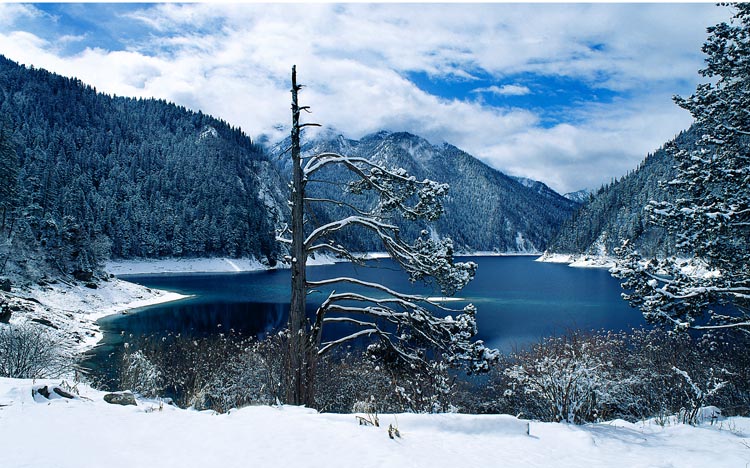
Located at the end of Ze Cha Wa Valley, the crescent-shaped Long Lake (Chang Hai) is over 100 meters deep, it is at the highest altitude and has the widest surface area of all Jiuzhai Valley’s lakes. This is the highest point visitors will reach in the park. Its water appears ink blue, and the surrounding peaks are snow-capped for much of the year. Surrounded by thick forests, it collects snow melt and rain flow from the surrounding peaks. In winter the frozen surface ice can be as thick as 60cm.
At the north end of the lake at the viewing platform is the Single Armed Old Man (Du Bi Lao Ren) Cypress tree. It is striking since one side is full of branches and leaves while the other side has none.
Ri Ze Valley
Roughly the same length as Ze Cha Wa Valley, Ri Ze Valley runs for 18km from Nuo Ri Lang in the centre of the park to the Virgin Forest at the top of the right branch of the “Y”. It is home to some of the most fascinating coloured lakes in Jiuzhai Valley, the tallest waterfalls and some of the parks most impressive forests.
The Virgin Forests
Altitude 3,060m, area 540 hectares

At the Virgin Forest (Yuan Shi Sen Lin), 40m lower in altitude than Long Lake, grow arbors that mainly include firs and spruces, shrubs such as honeysuckles, azaleas, arrow bamboo, as well as thick lichens. This area has a high content of negative oxygen ion which results in a natural oxygen bar in the forest!
Grass Lake
Altitude 2,910m, area 30,000 sq.m.
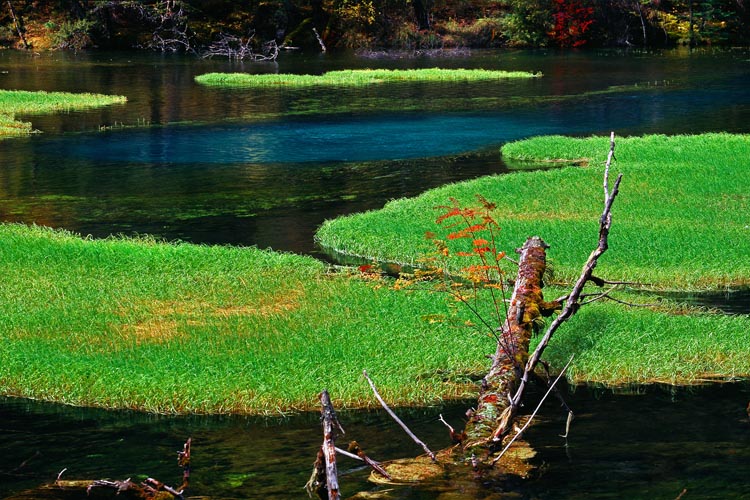
The long belt shaped, semi-swamp Grass Lake (Fang Cao Hai) is tucked under deep cliffs.
In summer and autumn, the grass groves and flowers appear to be yellow, white, red, and purple. Waterfowl such as swans, pheasants swoop in and out of the flowery banks.
Swan Lake
Altitude 2,905m, area 55,000 sq.m, depth 2 - 13m, the widest span 125m

The glittering water of Swan Lake (Tian E Hai) lies in the dense fir woods of Ri Ze Valley. A semi-marsh lake containing lots of carbonate material. Due to sluggish water flow and siltation in its upper channels, the lake is an excellent home for a variety of water plants, grasses and algae. Swans are frequent visitors to this lake, hence its name.
Arrow Bamboo Lake
Altitude 2,618m, depth 6m, area 170,000 sq.m.

The banks of Arrow Bamboo Lake (Jian Zhu Hai) is one of the many places where arrow bamboo, the favoured food of the giant panda, used to grow in abundance before it flowered and died.
In 2001, Chinese movie director Zhang Yimou selected this site for some of the scenes of the movie Hero because of its charming scenery.
Arrow Bamboo Falls
Altitude 2,618m, height 7m, width 150m.

Collapsed rocks form the dikes that separate the water into a number of small streams after falling the 7m of the Arrow Bamboo Falls (Jian Zhu Pu Bu). It is an arc-shaped waterfall with a large span and small drop. The contrast of the white water and blue lake create a dynamic yet still scene.
Panda Lake
Altitude 2,587m, average depth 14m, area 90,000 sq.m.

The transparent water of Panda Lake (Xiong Mao Hai) accompanied by the snow capped mountain peaks and blues skies set the scene for where Jiuzhai Valley’s Giant Pandas are said to come to drink, play and look for food although pandas have not been spotted in the area for many years.
Panda Lake Waterfalls
Altitude 2,592m, height 78m top width 50m, three levels of waterfall

Formed slowly over about 53,000 years, it is the highest and oldest of Jiuzhai Valley’s waterfalls. The Panda Lake (Xiong Mao Hai) is cut into several sections by protruding giant rocks. Thus, the overlapped waterfalls form a majestic sight. In winter, the waterfalls often freeze completely becoming a spectacular ice wall, in spring it is dry and in the late summer water cascades down in torrents.
Five Flower lake
Altitude 2,472m, depth 5m, area 90,000 sq.m.
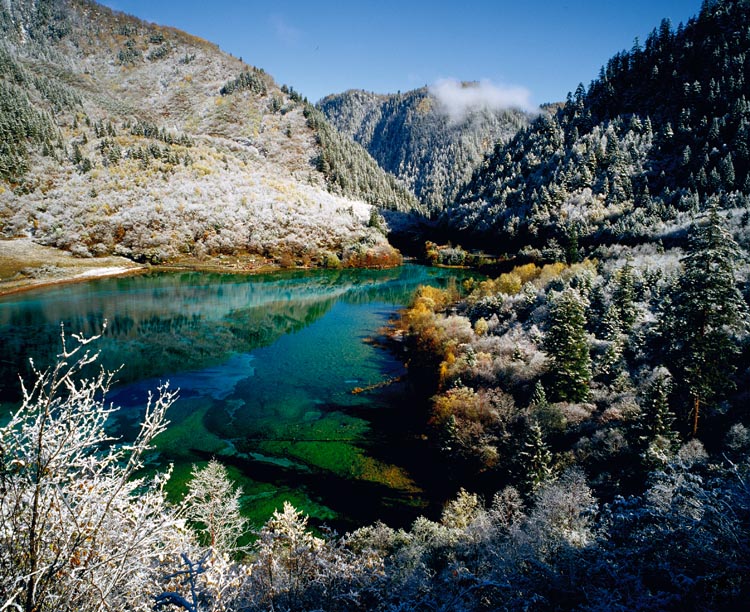
The Five Flower Lake (Wu Hua Hai) is regarded as one of the wonders of Jiuzhai Valley due to its breathtaking colours which are a result of its lake-bottom travertine and colourful algae. The colours are formed by unevenly distributed submerged plants. Five Flower Lake’s autumn reflections are a spectacular display of nature. The intense colour combinations of the trees reflected on the waters surface are one reason why Jiuzhai Valley is often referred to as a photographer’s heaven and a painter’s nightmare!
Peacock Riverbed

The Peacock Riverbed (Kong Que He Dao) covers 310 sq.m. at the north end of the Five Flower Lake (Wu Hua Hai) before winding its way through the forest on it way to the Golden Bell Lakes (Jing Ling Hai). It is possibly the most colourful lake in the whole of Jiuzhai Valley. The dark green, sapphire blue and golden yellow coloured water of the Peacock Riverbed are a favoured environment for the Songpan Naked Carp resident in these lakes.
Golden Bell Lake
Altitude 2,435m, depth 103m.
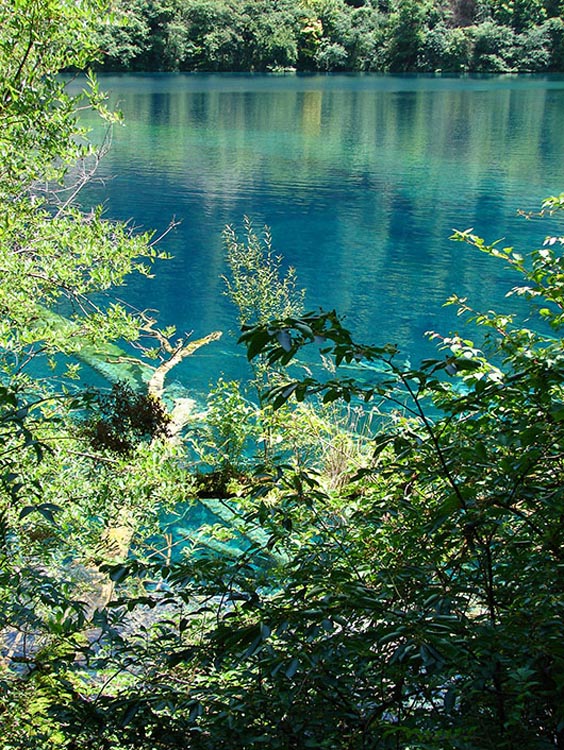
The Golden Bell Lakes (Jing Ling Hai) comprise of one large lake and one small lake twinned together, like a pair of bronze bells. The smaller one being the deepest of all of Jiuzhai Valley’s lakes at 103m. It was formed when gigantic collapsing substances blocked the river. It gets its name as a result of a tree dyke that divides it into two lakes that are believed to resemble the shape of two golden bells.
Pearl Shoals
Altitude 2.433m, width 160m, area 95,000 sq.m.
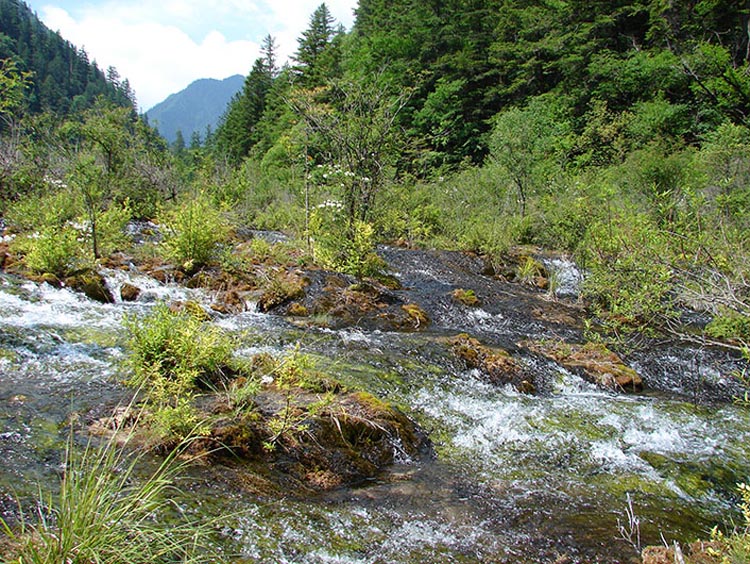
On the irregular travertine surface, water flows down to the magnificent Pearl Shoals Waterfall (Zhen Zhu Tan Pu Bu). At 160m in width, the very shallow flow encourages the growth of many unique algae and other flora that produce wonderful spring and early summer flowers. The travertine is a type of porous plant-rock that is always growing.
Pearl Shoals Waterfall
Altitude 2,433m, width 310m, highest drop 40m.
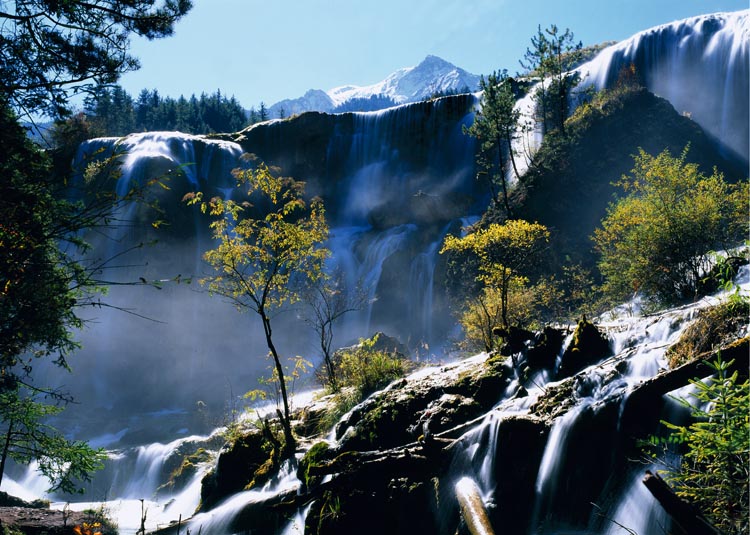
Water rushing from the Pearl Shoals (Zhen Zhu Tan) drops from top of the falls and forms a crescent waterfall. This is the most photographed waterfall in Jiuzhai Valley and along with many places in the park it is a very popular place for Chinese couples to have their wedding photos taken.
The waterfall is actually accreting which means it is growing outwards rather than eroding backwards like most waterfalls do. The reason for this is that calcium carbonate is combining with roots, leaves and branches to produce a matrix of cemented plant-stone which then continues to grow once established.
As the water flowing over the shoals is shallow and filtered, lacking abrasive sand and gravel materials, it has little erosive power that might otherwise cause the waterfall to erode back up the valley.
Mirror Lake
Altitude 2,390m, average depth 11m, deepest 24.3m, area 190,000 sq.m.
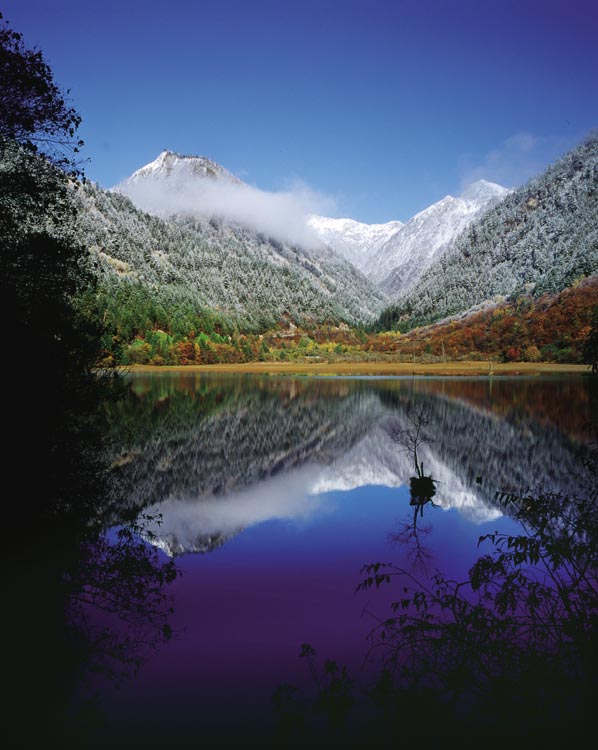
It is named Mirror Lake (Jing Hai) due to the perfect reflection of the surrounding mountains that can be seen in the still surface of the water in the morning. The spectacular setting inspired Chinese director, Zhang Yimou to film scenes for the multi Oscar winning, Crouching Tiger Hidden Dragon here. The lake was formed as a result of land slides blocking the water flow in the valley.
Ri Ze Gou Lakes
Altitude 2,375m.
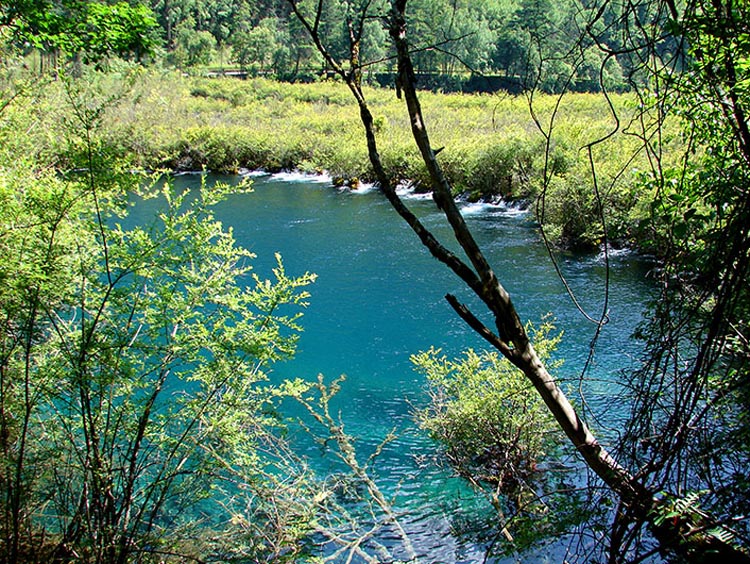
A total of 18 separate lakes, the Ri Ze Gou Lakes (Ri Ze Gou Qun Hai) are the starting point of Ri Ze Valley and are noted for their blue water and overlapped, multi-coloured waterfalls.
Zharu Valley
Zharu Valley is the home of all the eco-tourism activities in Jiuzhai Valley and is the only place visitors can stay overnight inside the national park by joining one of our hiking and camping tours. Zharu Valley offers challenging and rewarding hikes through China’s most spectacular national park. The plant life of Zharu includes 40% of the total number of the seed plant families that exist in the whole of China. The rich forests and mountains of Zharu Valley are also home to 63 mammals and the 220+ bird species in Jiuzhai Valley can all be found here. This is the only place thatyou can get off the beaten track and hike for one two or three days away from the rest of the park’s visitors.
Mirror Cliff

The giant, flat faced limestone Mirrof Cliff (Bao Jing Yan) climbs 400 meters from the Emerald River (Fei Cui He) below. Legend has it that, the mirror was built up by Zha Yi Zha Ga, king of all mountains to suppress a cruel demon.
Zharu Monestary

Approximately one kilometre into Zharu Valley, the Zharu Monastery is protected by high mountains, the Mirror Cliff and faces the peak of the Zha Yi Zha Ga sacred mountain.
Built of wood and clay, it is a typical Tibetan monastery, comprising of six parts: the main hall, scripture tower, music platform, tea house and guest hall, with lamas living quarters. The main hall has three golden roofs with four golden bells, and in the front is a gold wheel which symbolizes the life and death transformation. On the wheel is a pair of divine goats. The Statue of Sakyamuni is placed at the centre of the main hall, with religious instruments on the altar, and woollen blankets on the ground where early every morning lamas come for their religious service.
Re-construction began on the monastery in 2009 and is being funded by local people and the national park management. It is scheduled to be open to the public in 2012.
Zha Yi Zha Ga Mountain
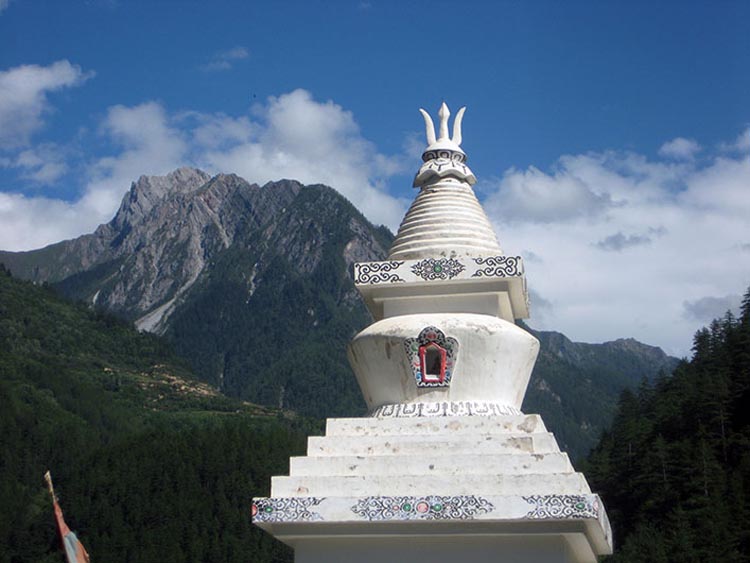
The magestic and sacred Zha Yi Zha Ga (the name of the Tibetan king of all mountains) rises to a height of 4,528m above sea level. Devout Benbo Tibetan pilgrims, who come from far and wide, do the Zha Yi Zha Ga kora (circumambulation) on the 15th day of the lunar month. The main eco-tourism hiking trail in the Zharu Valley is a three day trail around Zha Yi Zha Ga.
Zha Yi Zha Ga offers spectacular views and features an array of flora and fauna that is difficult to see in the main tourist valleys. The trail is a challenging and at times steep route that will bring you to altitudes of over 4,150m with spectacular scenery along the way.







